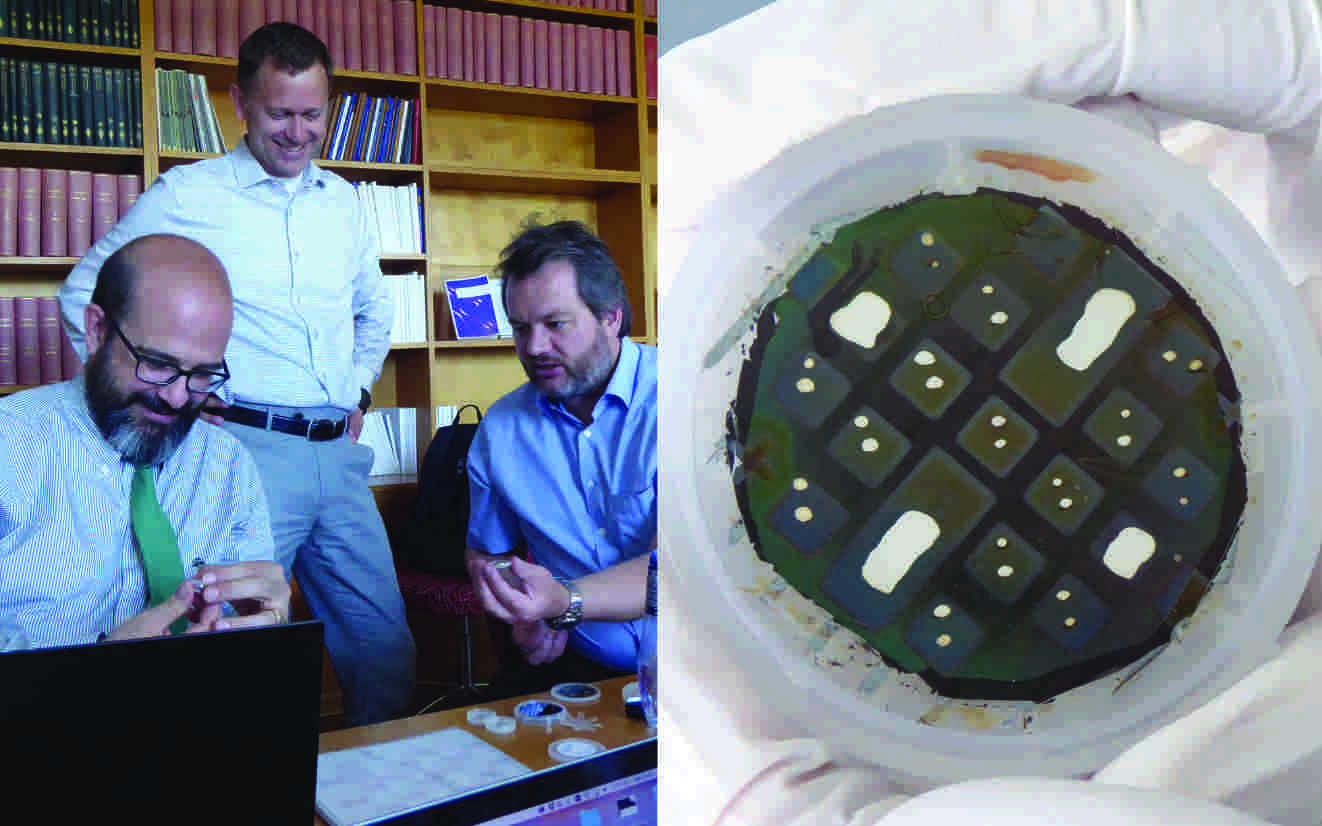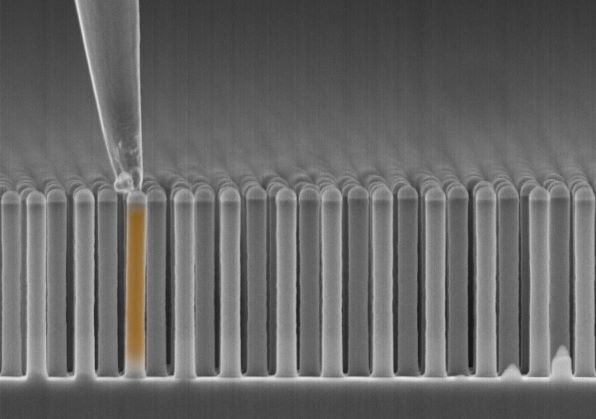Efficiency is the key!
The scientific progress of Nano-Tandem demonstrated that III-V nanowires represent a realistic opportunity in augmenting the performance of standard Si solar cells by adding a nanowire layer on the top.
Nanowires allow to significantly reduce material needs without compromising absorption or performance. Combining nanowires made from semiconductors with today’s silicon photovoltaic technology enables:
- Very high performance
- Efficient use of materials
- Low cost

Left: Silicon solar cell; Right: Tandem solar cell produced by stacking nanowires on a silicon bottom
The nanowires for the top layer were produced by three different methods
Firstly, in the monolithic approach, the process started from a standard, planar silicon cell. Then selective epitaxy in silicon oxide templates was used to produce the vertical nanowires on top. The fabrication includes the formation of specific p and n doped segments and electrical contact formation. Material characterization was an important aspect of our work.
Secondly, in the transfer route, the nanowires were grown on a native III-V substrate, which is the most controlled process yielding high quality nanomaterials. To integrate the nanowires on a Si cell, the nanowires in concept II are transferred from their growth substrate into a membrane, which is bonded to the Si cell. The transfer can be achieved by embedding the nanowires into a polymer film and by peeling off the composite membrane. Then, the expensive III–V substrate can be reused for further growth runs.
The main building block of the top cell is the array of ternary nanowires with a well-controlled morphology, composition and doping. Nano-Tandem project has pushed forward the conversion efficiency of binary InP nanowire solar cells. For InP nanowire grown by a bottom-up approach the new record has been set at 15%.
Thirdly, Aerotaxy, a substrate-free synthesis technique, which offers a radical reduction of the cell cost has been advanced beyond the state of the art. In Aerotaxy, nanowires grow from seed particles directly in the gas phase, and the resulting nanowire aerosol can be transferred into an ink for storage and further processing. One remarkable aspect of Aerotaxy is that this continuous process results in growth rates on the order of 1 μm/s, which is 100–1000 times faster than in metal organic vapor phase epitaxy. Size-selected catalyst particles are used to improve the nanowire homogeneity. Aerotaxy needs no lithography and is inherently scalable.
Methods to produce nanowire top cells and other research performed during the project
Results
The project has made advances in both monolithic nanowire integration route and in transfer route. It has been demonstrated that InGaP nanowire p-n junctions can be directly grown on Si for tandem solar cells. For InP nanowires grown on native substrate, the conversion efficiency was improved beyond the state-of-the-art. Tunnel diodes inside nanowires have been demonstrated. Low-cost aerotaxy method has shown its ability to synthesise p-n junction nanowires and ternary allow nanowires. Rear-side photonic light trapping suitable for a direct integration of nanowires on Si solar cell has been developed, which led to a new world record in conversion efficiency of III-V on Si solar cells (33.3% published in Nature Energy). The environmental impact of the nanowire PV technology was assessed on the lab scale and on the industrial scale and suggestions for limiting the negative ecological impact have been formulated.
The picture below shows EC-INEA Project officer Bernardo Abello Garcia together with Nano-Tandem researchers Ingvar Åberg and Gerald Siefer looking at the samples of the nanowire top-cells that were characterized and had significantly improved efficiency. 
Overview of project results
Here Magnus Borgström explains, why he believes semiconductor nanowires to be one of the most promising candidates for the next generation photovoltaics.
A bit of history:
The Nano-Tandem project builds on achievements of the AMON-RA project, where InP based nanowire solar cells with efficiency of 13.8 % were successfully demonstrated.
The AMON-RA project was a collaboration project of seven partners, financed by the EU 7th Framework Programme. It finished in September 2013.
Overview and results can be found on the project´s former webpage:
https://web.archive.org/web/20141219060621/http://www.amonra.eu/
